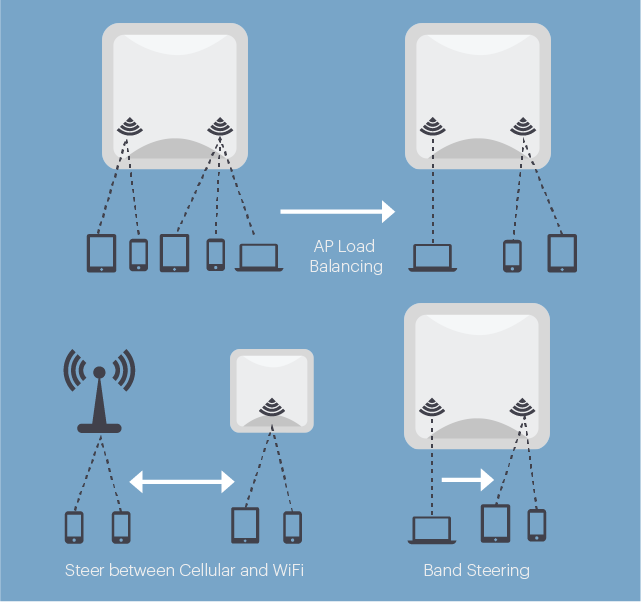Improving WiFi Client Connectivity ManagementImproving WiFi Client Connectivity Management
Wi-Fi Alliance addresses client steering challenges in WLANs.
August 24, 2017

WLANs use techniques such as band steering, AP load balancing, and sticky-client prevention for performance optimization. They require directing client connections to specific frequency bands and/or APs, which could be generically called "client steering." Today, these techniques rely on vendor-specific methods using 802.11 protocol constructs that are not primarily designed for client steering. The result is a makeshift approach that lacks robustness and often causes connectivity problems for clients.
To address this challenge, the Wi-Fi Alliance has been working on standards-based approach under the initiatives called Multiband Operations (MBO) and Optimized Connectivity Experience (OCE). The alliance is expected to finalize the MBO and OCE specifications and start certifying WiFi equipment using them by the end of this year. This will not only help address the issues with client steering, but will also cater to future requirements.
Band steering and load balancing issues
In band steering, also called spectrum load balancing, the AP dictates whether client uses 2.4 GHz or 5 GHz spectrum. The technique is primarily used by a dual-radio AP to steer clients from 2.4 GHz band to 5 GHz band because the latter offers a cleaner radio environment. It can also be used to steer non-mission critical clients from 5 GHz to 2.4 GHz. Band steering is also useful to steer clients between the two 5 GHz radios of a dual-radio AP that operates two different 5 GHz channels. Today, the steering is done by the AP through some combination of sending disconnect (disassoc or deauth) messages to the client with vague reason codes and ignoring the client's connection requests in the band where the AP does not want it to connect.
These improvised techniques are not without problems. A client may keep retrying the connection before switching to another band, which causes delays and wastes wireless bandwidth during retries. In some cases, a client may be forced to switch to another band even if it does not see enough signal quality in that band. Some clients may give up connecting to the AP altogether after seeing multiple failures to connect in the current band. To avoid abandoning the client, APs may make a heuristic decision at some point to give up steering and let the client operate in the undesirable band. Consequently, band steering's effectiveness is at the mercy of the client’s response to the AP’s pokes, and varies across diverse client implementations.

Mojo_Diagram for AP Load Balancing.png
AP load balancing and sticky-client prevention are other scenarios that require client steering. In AP load balancing, an overloaded AP in the WiFi network attempts to steer some clients to other, less loaded APs. Sticky-client prevention addresses the tendency of clients to remain attached to the current AP even as they move away from it. The sticky client remains connected to its present AP at a lower data rate. Low data-rate clients occupy higher air time on the channel thus causing inefficient utilization of wireless capacity. So, the AP needs to steer such client to another AP that is closer to the client. The drawbacks of the improvised steering techniques discussed above are also felt during AP load balancing and sticky client prevention.
Moving forward, the WiFi industry expects more bands will be available for unlicensed operation such as 60 GHz and TV white spaces. In such a multi-band network of the future, client steering will have even bigger role to play. There is also a use case for client steering in the carrier-managed WiFi network, where a client may need to be steered between unlicensed band and licensed cellular band depending on which spectrum better serves the client in a particular situation. Today, this works by always preferring WiFi over cellular. The smarter way would be to base this decision on the relative quality of WiFi and cellular signal.
MBO and OCE
The MBO and OCE initiatives aim to provide a robust, interoperable client-steering mechanism. They are based on the IEEE 802.11v and 802.11k standards, which have not seen widespread adoption in WiFi networks thus far. So, the alliance’s approach in the MBO and OCE initiatives is to specify a subset of features in these standards that are useful for client steering and endorse WiFi equipment implementing them via certification program. Setting aside the nitty gritty of protocol specification, conceptually MBO and OCE will improve client steering in the following ways:
An AP can now send well-defined steering messages to a client. The messages contain information elements such as precise reason, options available to the client to migrate to, and time allowed to migrate. The interoperable client can interpret this message and perform its migration gracefully.
A client can now share information with the AP about its capabilities, connection choices, and options it sees around to migrate. This results into better steering decisions by APs because now they take into account the client’s perspective.
The MBO and OCE can be introduced in the installed base with firmware upgrade; they do not require a hardware refresh. New equipment may already come certified for MBO and OCE. Another benefit is that these are backward compatible mechanisms, so they can operate in a mixed environment where clients that support MBO and OCE benefit from robust steering, while legacy clients continue to operate with existing steering techniques. I expect the WiFi industry will enthusiastically embrace MBO and OCE to address client-steering challenges of today and to cater to future requirements.
About the Author
You May Also Like




